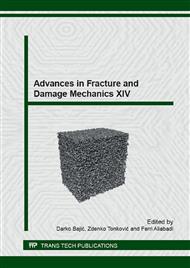[1]
F.A. Mohamed & T.G. Langdon: Metall. Trans. Vol. 5 (1974), pp.2339-2345.
Google Scholar
[2]
H.J. Frost & M.F. Ashby: Deformation mechanism maps: the plasticity and creep of metals and ceramics(Pergamon press, 1982).
Google Scholar
[3]
J. Lemaitre & R. Desmorat: Engineering damage mechanics: ductile, creep, fatigue and brittle failures(Springer Science & Business Media, 2005).
DOI: 10.1002/zamm.200590044
Google Scholar
[4]
B. Wilshire & A.J. Battenbough: Mat. Sci. Eng. A Vol. 443 (2007), pp.156-166.
Google Scholar
[5]
M.T. Whittaker & B. Wilshire: Mat. Sci. Eng. A Vol. 527(2010), pp.4932-4938.
Google Scholar
[6]
A.C.F. Cocks & M.F. Ashby: Creep fracture by void growth (Springer Berlin Heidelberg, 1981).
Google Scholar
[7]
I. Benedetti & F. Barbe, Modelling Polycrystalline Materials: An Overview of Three-Dimensional Grain-Scale Mechanical Models. Journal of Multiscale Modelling, 5(01), (2013).
DOI: 10.1142/s1756973713500029
Google Scholar
[8]
A. Needleman & J.R. Rice: Acta Metall. Vol. 28(1980), pp.1315-1332.
Google Scholar
[9]
E. Van der Giessen, M.W.D. Van der Burg, A. Needleman & V. Tvergaard: J. Mech. Phys. Solids Vol. 43(1995), pp.123-165.
DOI: 10.1016/0022-5096(94)00059-e
Google Scholar
[10]
M. Vöse, B. Fedelich & J. Owen: Comput. Mater. Sci. Vol. 58(2012), pp.201-213.
Google Scholar
[11]
P. Onck & E. van der Giessen: Comput. Mater. Sci. Vol. 13(1998), pp.90-102.
Google Scholar
[12]
C.H. Yu, C.W. Huang, C.S. Chen, Y. Gao & C.H. Hsueh: Eng. Fract. Mech., Vol. 93(2012), pp.48-64.
Google Scholar
[13]
M. Vöse, F. Otto, B. Fedelich & G. Eggeler: Mech. Mater. Vol. 69(2014), pp.41-62.
Google Scholar
[14]
O. Ozhoga-Maslovskaja, K. Naumenko, H. Altenbach & O. Prygorniev: Comput. Mater. Sci. Vol. 96 (2015), pp.178-184.
DOI: 10.1016/j.commatsci.2014.08.050
Google Scholar
[15]
I. Benedetti & M.H. Aliabadi: Comput Mater Sci, Vol. 67 (2013), pp.249-260.
Google Scholar
[16]
I. Benedetti & M.H. Aliabadi: Comput Meth Appl Mech Eng, Vol. 265 (2013), pp.36-62.
Google Scholar
[17]
I. Benedetti & M.H. Aliabadi, Comput Meth Appl Mech Eng, Vol. 289 (2015), P. 429-453.
Google Scholar


